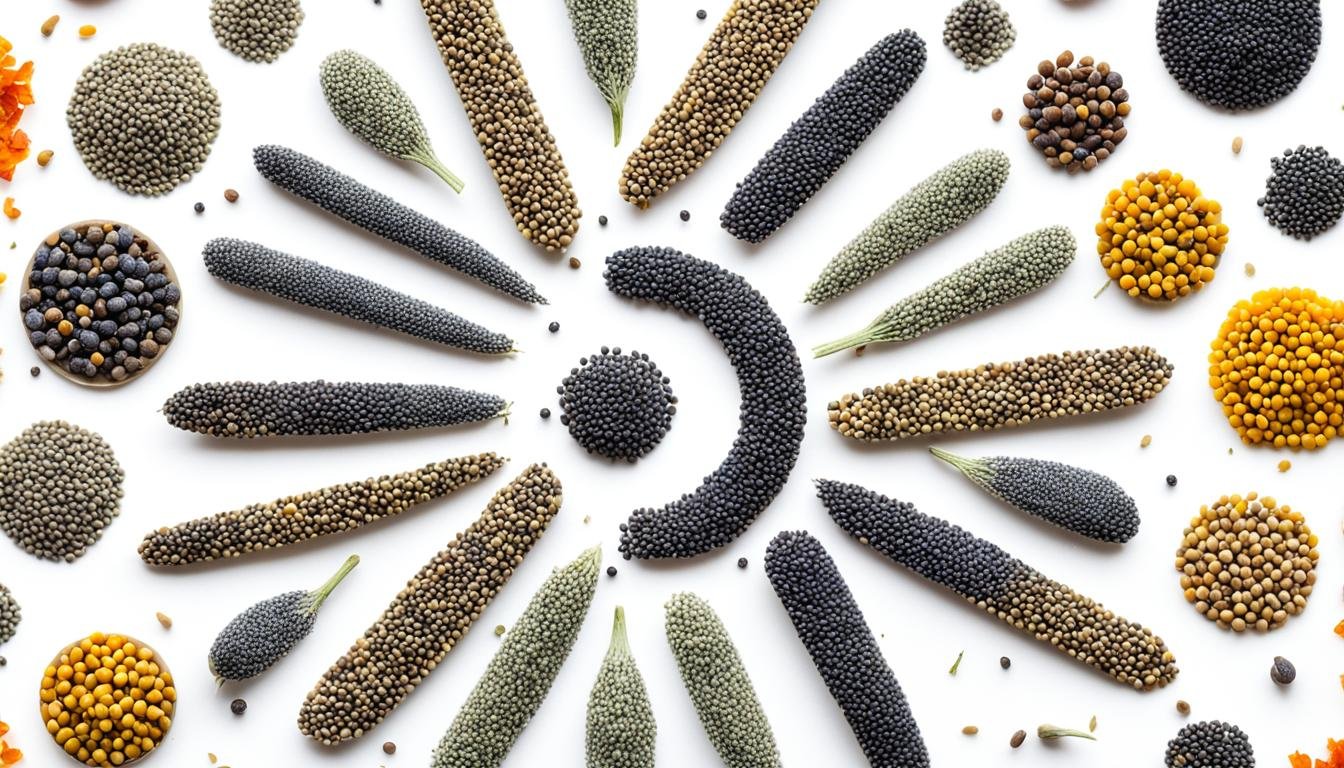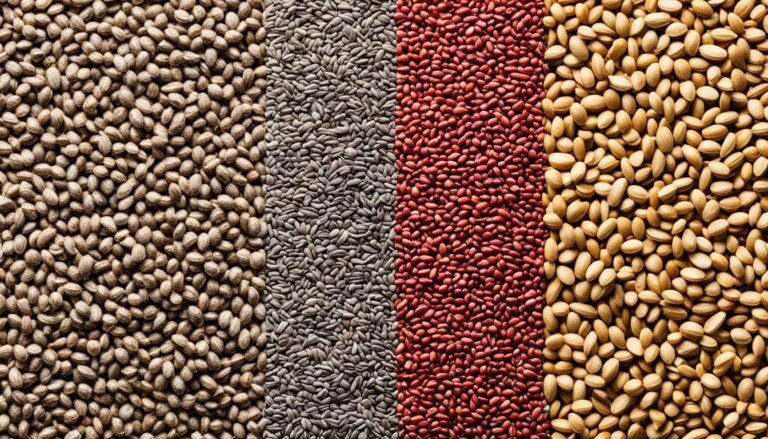Exploring Types of Poppy Seeds: A Culinary Guide

Did you know a single poppy plant can produce thousands of tiny, flavorful seeds? These seeds have been a key part of human culture for thousands of years. They’re used in many cuisines worldwide. From the bold, nutty black poppy seeds used in Western baking to the milder, creamier white variants in Indian dishes, poppy seeds are diverse and interesting.
Let’s explore the different types, history, and culinary uses of this amazing ingredient together.
The Ancient Origins of Poppy Seeds
Poppy seeds have a long and interesting history. They go back to ancient times when they were more than just food. They were important in ancient Egyptian and Sumerian cultures. Poppy seeds have traveled the world, becoming part of many cuisines.
Tracing the Historical and Cultural Significance
Poppy seeds come from Southeastern Europe and Western Asia. The Papaver somniferum, or breadseed poppy, is their home. People in Europe have grown poppy seeds since the Neolithic era. They are a big part of our food and culture.
Studies show that opium poppy was in the Mediterranean as early as 5622 to 4050 years ago. It was found in the central and western Mediterranean, northwestern Europe, and the western Alps. This means that people in the Mediterranean grew and used opium poppy from the middle of the sixth millennium BCE.
Opium poppy was brought to areas west of the Rhine around 5300–5200 years ago. It reached the western Alps about 5000–4800 years ago. Poppy seeds were introduced to nearly 40 sites in temperate Europe around 5300–5000 years ago.
In ancient Egypt and Sumeria, poppy seeds were more than food. They were important in ceremonies and had deep meanings. This shows how poppy seeds have always played a big role in human history.
“Papaver somniferum, commonly known as breadseed poppy or opium poppy, is native to Southeastern Europe and Western Asia.”
Today, poppy seeds are still important in many cuisines around the world. They are used in European pastries and breads, and in many savory dishes. Knowing about the history and cultural importance of poppy seeds helps us enjoy them more.

Nutritional Powerhouse: Poppy Seeds’ Surprising Benefits
Poppy seeds are more than just a tasty addition to your meals; they are a nutritional powerhouse. They are full of essential nutrients that offer many health benefits. These tiny seeds might surprise you with their health perks.
A tablespoon of poppy seeds is packed with minerals like calcium, phosphorus, and magnesium. These are great for boosting your mineral intake. They also have iron and zinc, which help keep your blood healthy and your immune system strong.
Poppy seeds come in different types, each with its own nutrient profile. Black poppy seeds have more fat, while white ones have more carbs. But one thing is sure: poppy seeds are a nutritional powerhouse.
| Nutrient | Quantity per Tablespoon |
|---|---|
| Calories | 55 |
| Protein | 1.9 g |
| Carbohydrates | 2.6 g |
| Fiber | 1.1 g |
| Fat | 4.7 g |
| Calcium | 50 mg |
| Iron | 0.7 mg |
| Magnesium | 27 mg |
| Phosphorus | 52 mg |
| Zinc | 0.3 mg |
Poppy seeds are more than just a tasty addition to your meals; they offer many health benefits. They can help with female fertility, improve sleep, support bone health, and aid digestion. Adding poppy seeds to your diet is a simple way to boost your health.

“Poppy seeds are a true nutritional powerhouse, offering an impressive array of essential vitamins, minerals, and health-promoting compounds.”
Looking to improve your bone health, support your immune system, or just add crunch to your dishes? Poppy seeds are a versatile and nutritious choice. Discover the many uses and health benefits of this amazing ingredient and why it should be in your pantry.
Black, White, and Blue: Decoding the Colors
The world of poppy seeds is full of color and taste. Each color has its own unique flavor and uses in cooking. From the bold black seeds to the creamy white and the delicate blue, knowing the differences is important.
Flavor Profiles and Culinary Uses
Black poppy seeds are known for their strong, nutty taste. They add depth to breads, pastries, and cakes. On the other hand, white poppy seeds have a milder taste. They are often used in Indian cooking for sauces and pastes.
Blue poppy seeds have a slightly sweet, nutty flavor. They are popular in Central European cooking. These seeds can be used in many dishes, from savory to sweet.
| Poppy Seed Variety | Flavor Profile | Culinary Uses |
|---|---|---|
| Black Poppy Seeds | Bold, nutty | Breads, pastries, cakes |
| White Poppy Seeds | Mild, creamy | Sauces, pastes |
| Blue Poppy Seeds | Slightly sweet, nutty | Central European cuisine |
Exploring black, white, and blue poppy seeds can open up new culinary possibilities. They add depth, texture, and unique flavors to dishes.

“Poppy seeds are a versatile culinary gem, each variety offering a distinct flavor profile that can elevate a dish to new heights.”
Unlocking Poppy Seeds’ Digestive and Bone Health Potential
Poppy seeds are more than just a tasty addition to your meals. They are a nutritional powerhouse that can boost your digestive and bone health. Let’s see how these small seeds can make a big impact on your health.
Digestive Health Boost
Poppy seeds are known for their high fiber content. Just a tablespoon of these seeds has an amazing 19.5 grams of fiber. This makes them a great choice for your diet. Fiber helps with regular bowel movements, prevents constipation, and supports a healthy gut.
Strengthening Bones
Poppy seeds are also great for your bones. They are full of minerals like calcium, magnesium, and phosphorus. These minerals are key for strong, healthy bones. A 100-gram serving of poppy seeds gives you 144% of the daily calcium you need. Eating poppy seeds regularly can help prevent bone diseases like osteoporosis as you get older.
Poppy seeds are also packed with zinc, which is important for bone health. They also have oleic acid, a fatty acid that reduces inflammation and supports bone health.
| Nutrient | Amount in 100g Poppy Seeds | % of Daily Recommended Intake |
|---|---|---|
| Calcium | 1,154mg | 144% |
| Magnesium | 371mg | 98% |
| Iron | 11.5mg | 75% |
| Zinc | 7.5mg | 68% |
So, if you want to improve your digestive health or strengthen your bones, poppy seeds are a great choice. Add them to your favorite dishes or enjoy them as a healthy snack to reap their benefits.

“Poppy seeds are a hidden gem when it comes to promoting overall health and wellness. Their impressive nutritional profile makes them a must-have ingredient in any well-rounded diet.”
Types of Poppy Seeds for Culinary Adventures
Poppy seeds come in many types, each with its own flavor and uses in cooking. Whether you’re a pro chef or a home cook, learning about poppy seeds can open up new cooking possibilities.
Common poppy seeds include black, white, and blue types. Black poppy seeds have a strong, nutty taste. They’re great for baked goods like breads, bagels, and pastries. White poppy seeds are milder and creamy. They’re good for savory dishes, dips, and sauces.
Blue poppy seeds are also available. They have a sweet, floral smell and a crunchy texture. They add a unique touch to both sweet and savory recipes.
There are more poppy seed types too. You might find brown, yellow, and red ones. Each has its own flavor and uses in cooking.
Exploring poppy seeds can be fun for cooks at home or in the kitchen. It’s a great way to add something new to your cooking. Whether you want to spice up your baked goods or add a nutty flavor to savory dishes, poppy seeds can help.
| Poppy Seed Variety | Flavor Profile | Culinary Applications |
|---|---|---|
| Black Poppy Seeds | Bold, nutty | Baked goods (breads, bagels, pastries) |
| White Poppy Seeds | Mild, creamy | Savory dishes, dips, sauces |
| Blue Poppy Seeds | Slightly sweet, floral | Sweet and savory recipes |
| Brown Poppy Seeds | Earthy, robust | Marinades, rubs, and seasoning blends |
| Yellow Poppy Seeds | Mild, delicate | Rice dishes, salads, and side dishes |
| Red Poppy Seeds | Intense, slightly peppery | Spice mixes, pickles, and condiments |
Learning about the different poppy seeds and their flavors can open up new cooking adventures. It can make your dishes more interesting with new textures and tastes.
“Poppy seeds are a versatile ingredient that can transform a dish from ordinary to extraordinary. Explore the different types and discover how they can add depth and complexity to your cooking.”
Baking Delights: Incorporating Poppy Seeds in Pastries
From Strudels to Breads and Beyond
Poppy seeds are a favorite in baking, adding a crunchy texture and nutty taste to many pastries and breads. In European baking, black poppy seeds are often used on breads and rolls. In Central Europe, they’re a key part of poppy seed strudel, a popular pastry filled with a sweet poppy seed mix. Poppy seeds also work well in cakes, muffins, and cookies, making them more interesting and tasty.
Poppy seed bread is a great example of poppy seeds in baking. It’s perfect for breakfast, a snack, or dessert. The poppy seeds add a nutty, slightly sweet flavor to the soft bread. You can sprinkle them on top or mix them into the dough for extra flavor.
If you love sweets, poppy seed pastries are a treat. The mix of crisp pastry and creamy poppy seed filling is amazing. From traditional strudels to delicate Danish pastries, poppy seeds make these treats even better.
| Ingredient | Amount |
|---|---|
| Poppy seeds | 3 cups |
| Warm whole milk | 1 1/4 cups |
| Granulated sugar | 1/3 cup |
| Kosher salt | 1 tsp |
| Active dry yeast | 2 tsp |
| Large egg | 1 |
| Egg yolk | 1 |
| All-purpose flour or bread flour | 3.5 cups |
Whether you’re making a classic poppy seed strudel, baking poppy seed breads, or trying out poppy seed pastries, poppy seeds are a great choice. They add a special touch to your baking, bringing rich flavors and interesting textures.
“Poppy seeds add a unique and delightful crunch to any baked good, elevating the flavors and textures to new heights.”
Savory Surprises: Poppy Seeds in Global Cuisines
Poppy seeds are not just for sweets; they’re also key in savory dishes worldwide. Let’s dive into how these versatile seeds add depth to global cuisine. They can make your cooking more complex and exciting.
In Indian cuisine, white poppy seeds become a smooth paste. This paste is then mixed into curries and gravies. It adds a creamy texture and a nutty flavor. This shows how well poppy seeds fit into Indian cooking, blending with spices and aromas.
Poppy seeds are also great for modern dishes. You can sprinkle them on salads for crunch or use them to coat meats and fish. They let you get creative with poppy seeds in global cuisines, poppy seeds in savory dishes, and poppy seed uses in international cooking.
“Poppy seeds are the unsung heroes of the spice cabinet, lending their distinctive flavor and texture to a wide array of savory preparations around the world.”
Poppy seeds come from Turkey, Spain, and Czechia. They’re a global ingredient. Whether you’re making Indian curries or adding crunch to salads, poppy seeds can take your dishes to the next level.
When you start cooking, think about using poppy seeds in global cuisines, poppy seeds in savory dishes, and poppy seed uses in international cooking. From Indian gravies to Mediterranean salads, these small seeds can change your dishes in big ways.
The Versatile Kitchen Companion: Creative Uses for Poppy Seeds
Poppy seeds are more than just a bagel topping or a pastry filling. They can make many dishes better, from salads to smoothies, and even main courses. Discover how poppy seeds can add flavor and texture to your meals.
Poppy Seeds in Salads and Dressings
Add crunch to your salads with a sprinkle of poppy seeds. They taste nutty and slightly sweet, perfect with many greens and fruits. Boost your salads with homemade dressings like a creamy poppy seed vinaigrette or a tangy poppy seed ranch.
| Creamy Poppy Seed Dressing | Poppy Seed Vinaigrette |
|---|---|
| 3/4 cup mayonnaise 3 tablespoons apple cider vinegar 1/4 cup sugar 1/2 teaspoon dry mustard 1/2 teaspoon diced onion 2 teaspoons salt 2 teaspoons poppy seeds | 1 cup oil 3/8 cup rice vinegar 3/8 cup white vinegar 3/4 cup sugar 1 tablespoon poppy seeds 3/4 teaspoon ground mustard 1 medium purple onion |
Both dressings keep well in the fridge for about 4 days. They’re a tasty and easy addition to your salads.
Poppy Seeds in Smoothies and Drinks
Add poppy seeds to your smoothies for extra nutrition. They’re high in protein and fiber, keeping you full. Sprinkle them on your yogurt or oatmeal for a crunchy, nutty taste.
You can also use poppy seeds in cocktails and mocktails. Infuse your drinks with their unique flavor for a memorable experience.
Remember, start with about 4 teaspoons of poppy seeds and adjust to taste. A little goes a long way.
Safety and Moderation: Addressing Concerns
Poppy seeds are usually safe for most people. But, it’s important to think about a few things. They might have trace amounts of opiates like morphine and codeine from the poppy plant. These amounts are usually small, but eating a lot of poppy seeds could show up on drug tests.
For pregnant women, eating poppy seeds should be done carefully. This is because they have trace opiates. Also, some people might be allergic to poppy seeds, so it’s smart to try a little bit first to see if you react badly.
| Potential Side Effects of Poppy Seeds | Recommendations |
|---|---|
| Positive drug test results | Consume poppy seeds in moderation, especially if subject to regular drug testing |
| Allergic reactions | Introduce poppy seeds into your diet gradually to monitor for any allergic responses |
| Excessive consumption during pregnancy | Limit poppy seed intake during pregnancy due to the trace amounts of opiates |
Knowing about poppy seed safety issues is key. Be careful with them, especially if you’re often tested for drugs or if you’re pregnant. By being cautious and knowing the potential side effects of poppy seeds, you can enjoy them safely in your cooking.
“Poppy seeds are a beloved ingredient in various global cuisines, known for their nutty flavor and crunchy texture.”
Selecting and Storing: Tips for Preserving Poppy Seed Freshness
When buying fresh poppy seeds, look for ones that are bright and free from moisture or mold. Keeping their flavor and nutrients means storing them right.
To keep poppy seed quality high, put them in an airtight container in a cool, dry spot. This keeps their natural oils in and stops them from going bad. Whole seeds can last up to six months this way. But ground seeds don’t last as long, so use them quickly.
For longer storage, put your poppy seeds in the fridge or freezer. The fridge can keep them fresh for a year, and the freezer for two years. Always use an airtight container to keep moisture and air out.
| Storage Method | Shelf Life |
|---|---|
| Room Temperature (Airtight Container) | Up to 6 months |
| Refrigerator | Up to 1 year |
| Freezer | Up to 2 years |
Follow these easy tips for buying fresh poppy seeds and storing poppy seeds. This way, your cooking will always have the best flavor and freshness from these versatile seeds.
“Proper storage is the key to preserving the unique taste and nutritional benefits of poppy seeds.”
Conclusion
Poppy seeds are small but powerful. They bring flavor, nutrition, and versatility to your meals. You can use them to add crunch to baked goods, enrich sauces, or enjoy their health benefits. They are packed with protein, fiber, and healthy fats, and are full of antioxidants.
Adding poppy seeds to your diet is easy and fun. It brings flavor and nutrition to your meals. You can try them in many dishes, from savory to sweet. Their unique taste and aroma can make any recipe better.
Poppy seeds show us the power of small ingredients. They can make your cooking and baking more exciting. By using them, you can enjoy their many benefits and add delicious flavors to your meals. They are a key ingredient for a tasty and healthy diet.
FAQ
What are the different types of poppy seeds?
Poppy seeds come in many types, like black, white, and blue. Each type has its own taste and uses in cooking.
How are poppy seeds used in different cuisines around the world?
Poppy seeds are used in many ways across the globe. In Western baking, black poppy seeds are common. In Indian cooking, white poppy seeds are ground into sauces. Central European cooking often uses blue poppy seeds.
What are the health benefits of consuming poppy seeds?
Poppy seeds are full of nutrients. They help with digestion, bone health, and provide minerals like calcium, phosphorus, and magnesium.
Are there any safety concerns with consuming poppy seeds?
Poppy seeds have trace amounts of opiates. This is something to know, especially if you’re being drug tested. Pregnant women should not eat too many poppy seeds.
How should poppy seeds be stored to maintain their quality?
Keep poppy seeds in a cool, dry place in a sealed container. This keeps their oils fresh and prevents them from going bad. Whole poppy seeds can stay fresh for six months if stored right.






